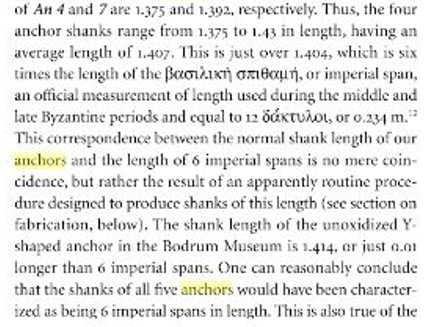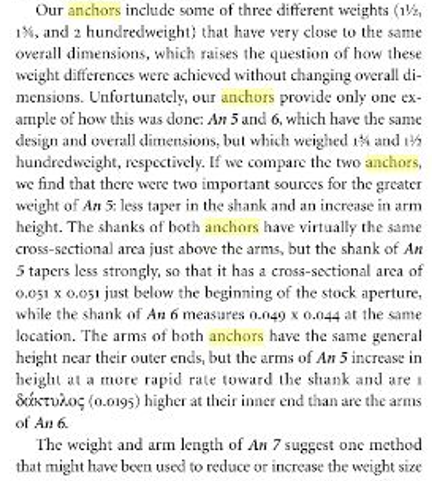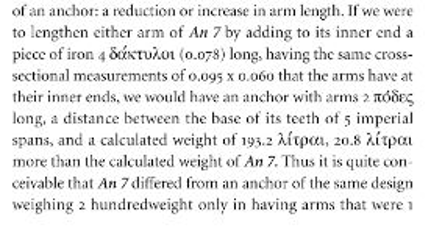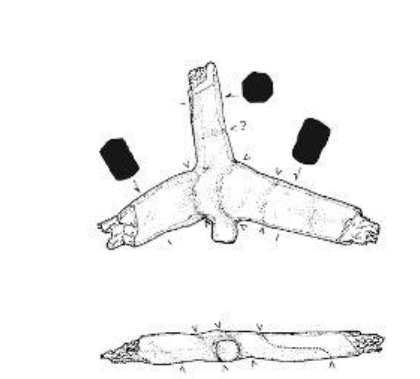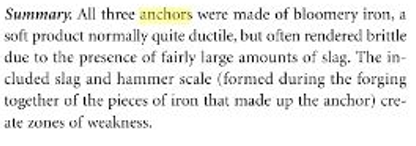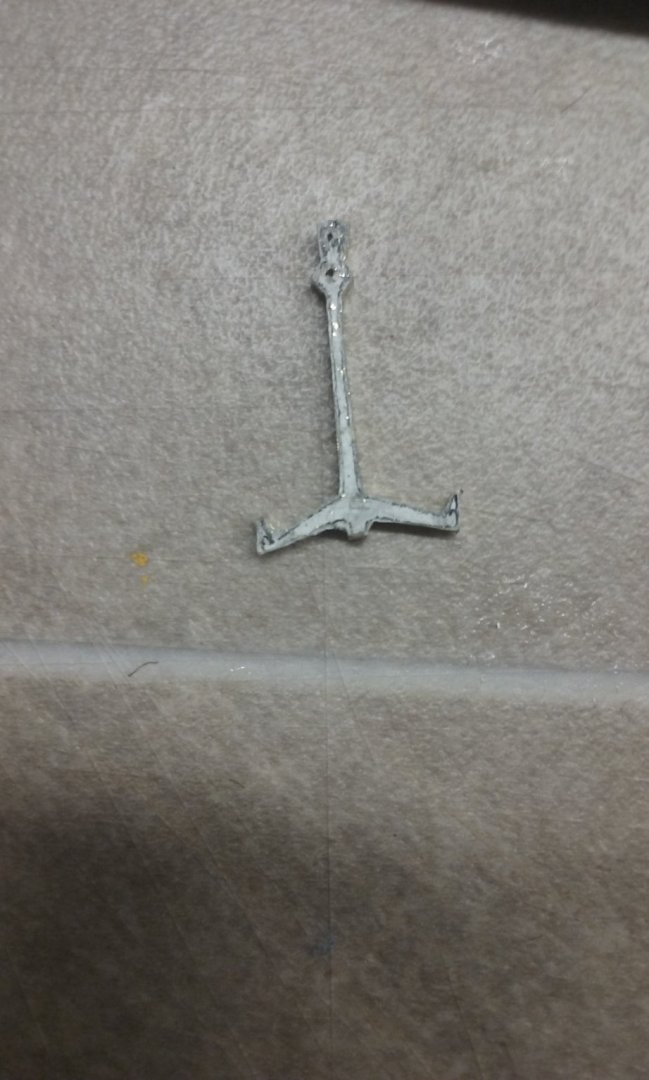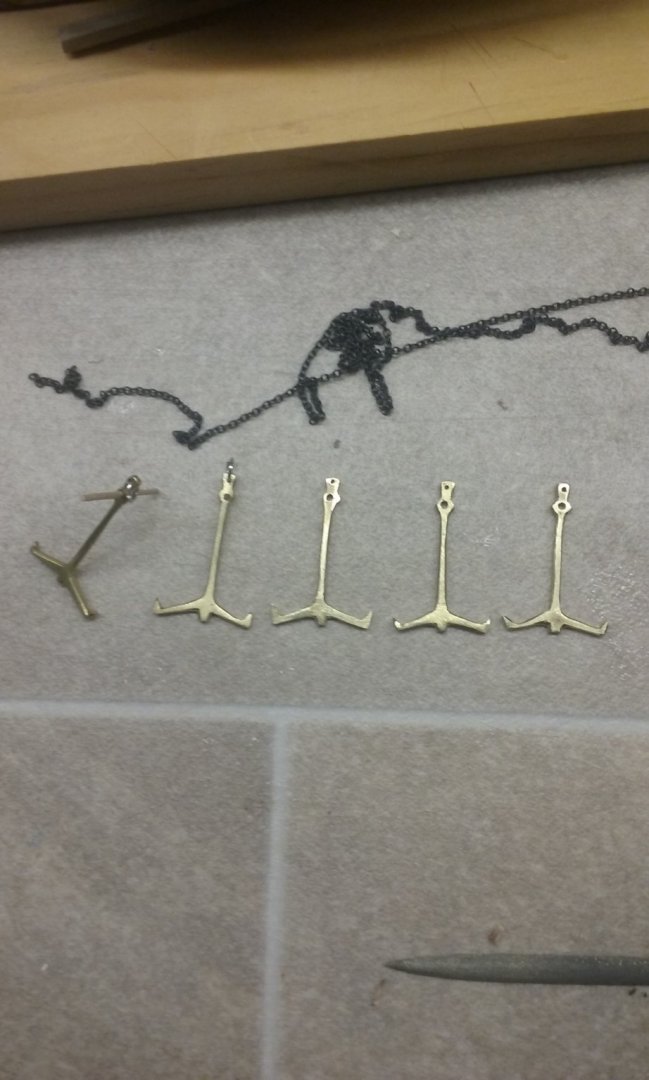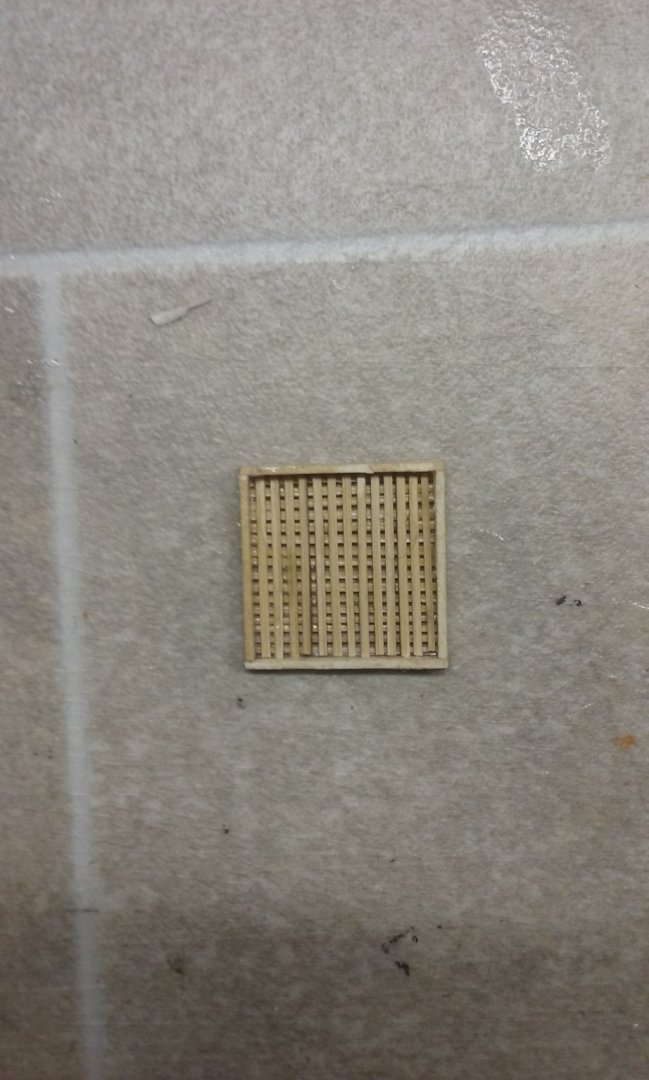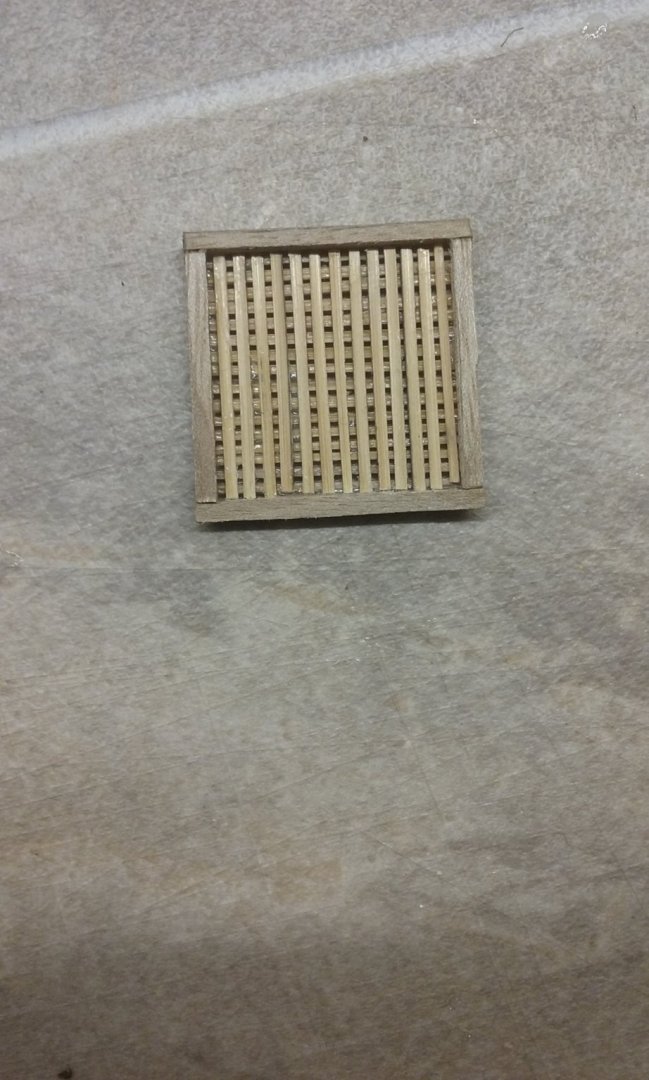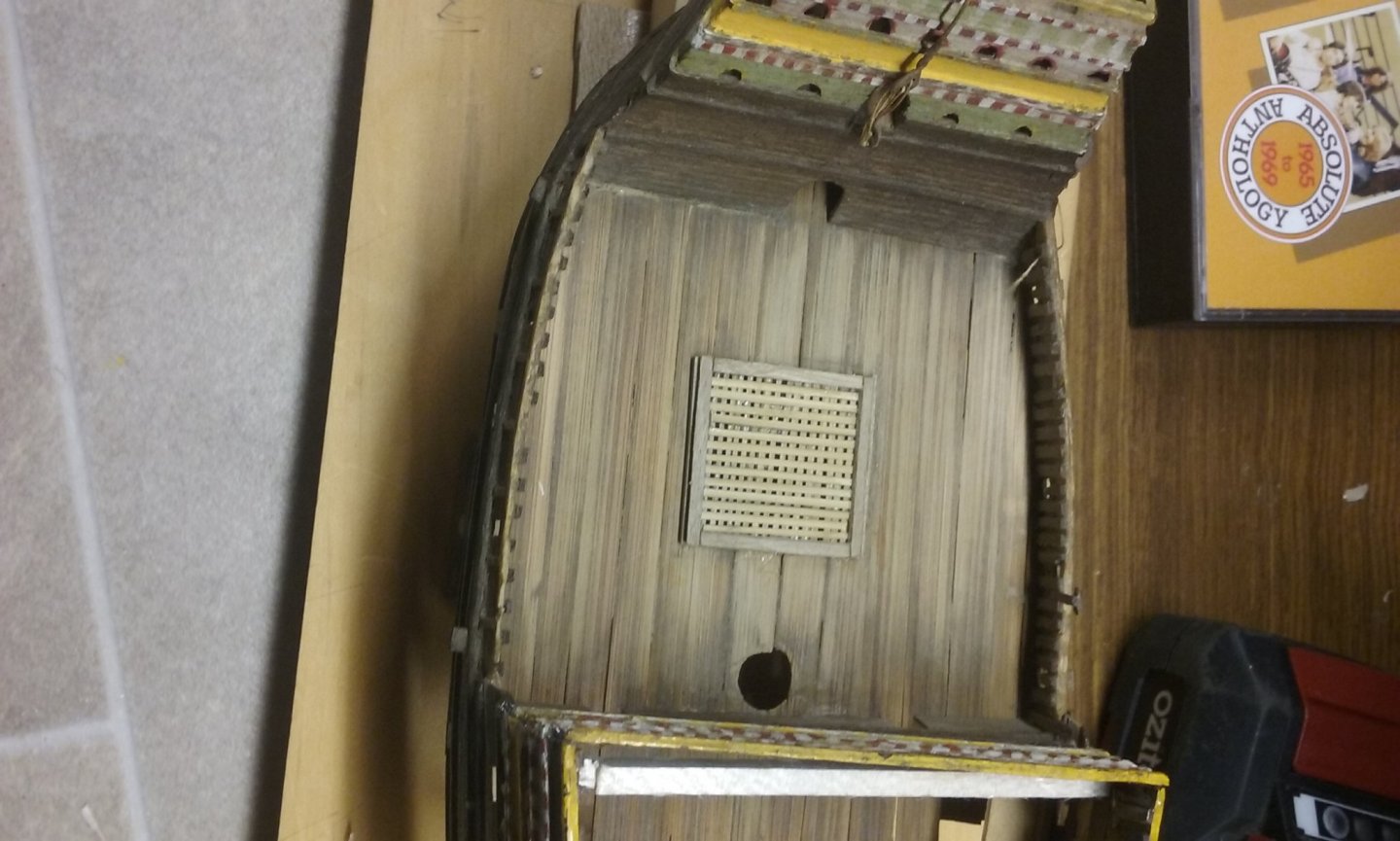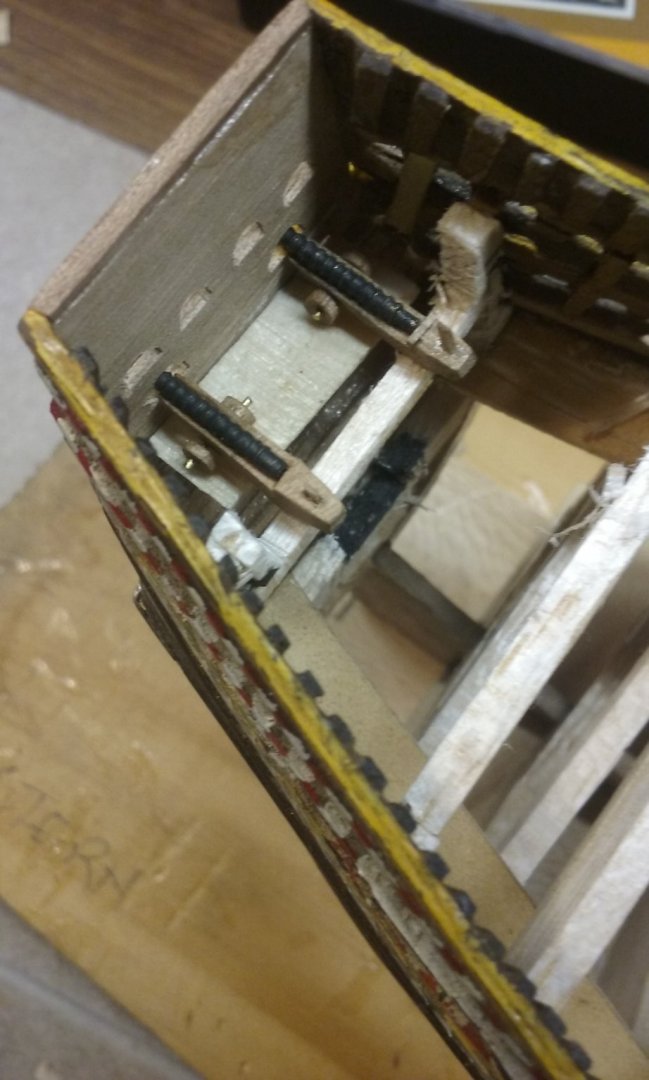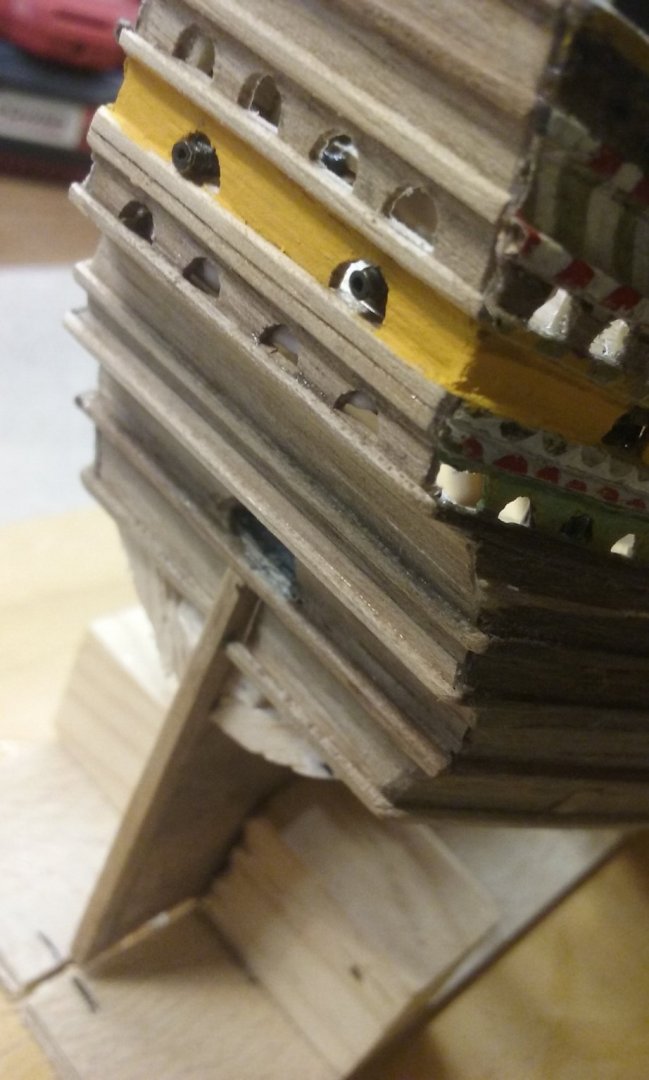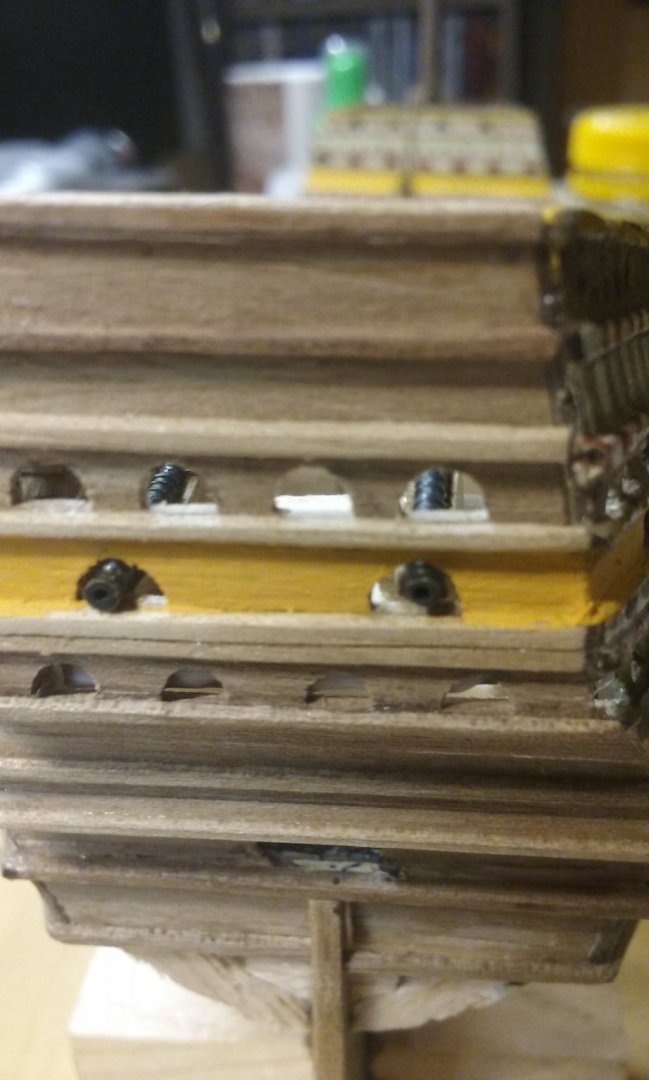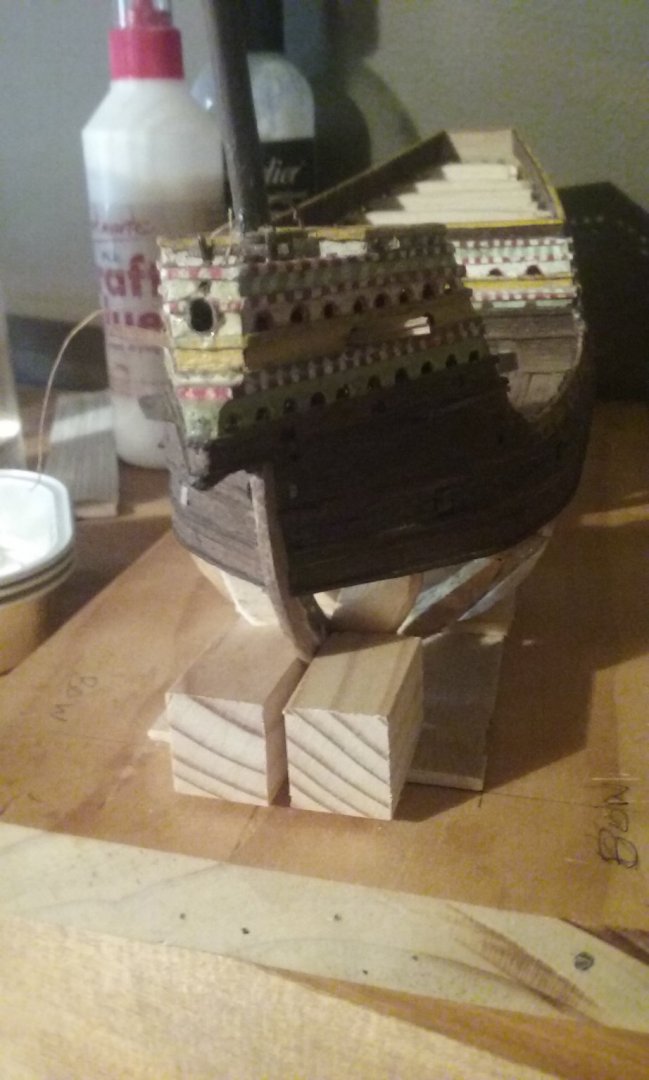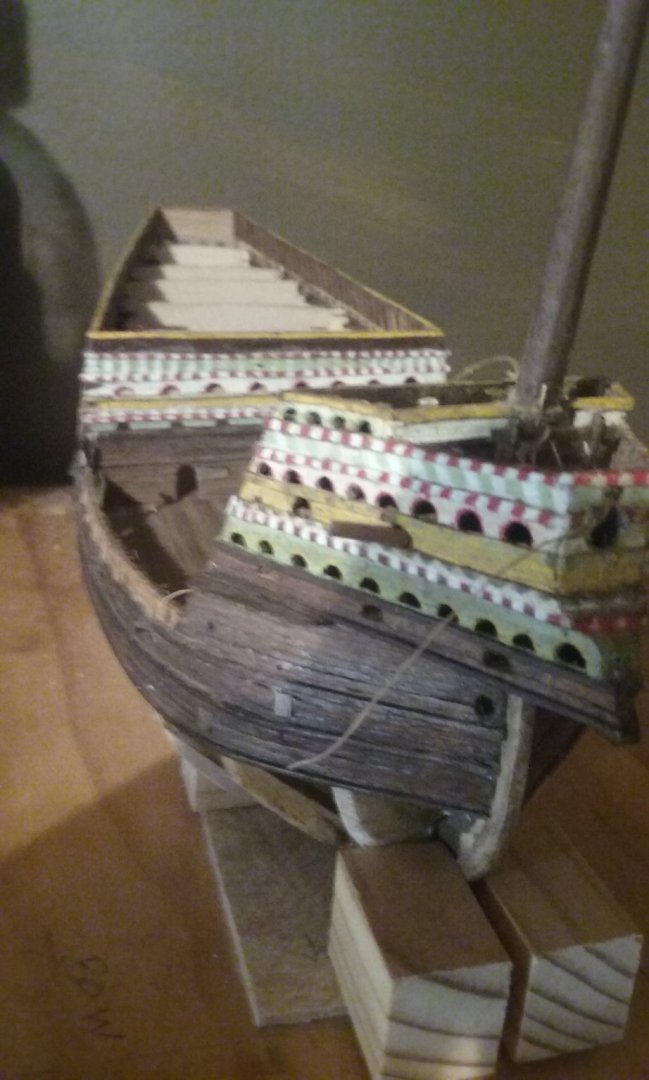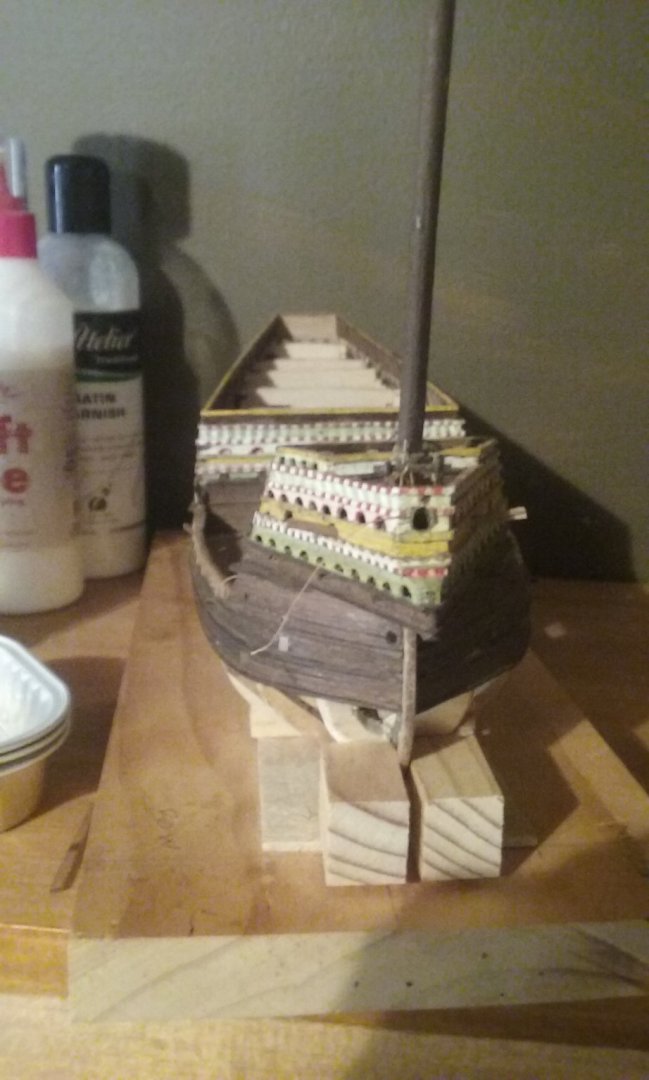-
Posts
7,987 -
Joined
-
Last visited
Content Type
Profiles
Forums
Gallery
Events
Everything posted by Louie da fly
-
Makes sense - though isn't the Mediterranean tideless? However, Mediterranean storms can be very fierce and unpredictable - anchors fixed into the beach would help guard against them. Steven
-
Okay; a 1 hundredweight anchor (112 pounds) is almost exactly 50 kg. One and a half hundredweight is 76 kg, one and 3/4 hundredweight is 89 kg and 2 hundredweight is 101 kg. A hundredweight can be lifted without too much trouble by someone who is strong and fit, and for people accustomed to heavy loads an anchor of that weight wouldn't be a problem. Two men (or perhaps only one) could lift an anchor twice that heavy. For some basis of comparison see Olympic weightlifting records at https://en.wikipedia.org/wiki/List_of_Olympic_records_in_weightlifting - how relevant this is to mediaeval sailors I'm not sure - weightlifting isn't my forte). How effective an anchor of this weight would be in holding a dromon at its mooring is anybody's guess, but I'd assume several would be needed. On the other hand, it was customary for galleys to be pulled up on shore (backwards) overnight, so I'm not sure how much use anchors got. And for holding ground in a storm, well . . . galleys were very easily swamped at the best of times, so I don't know how much use the anchors would have been. Further and further into the unknown . . . Steven
-
A wonderful job, Marcus! I can't wait to see her after second planking. She's going to be very beautiful. As an Australian, I find this build fascinating. My first history book when I was in primary school in Western Australia was called "Australia since 1606" and I heard all about the Dirk Hartog and de Vlamingh silver plates and I've since seen the latter one in the shipwreck Museum in Fremantle, along with the relics of the Batavia, Zuytdorp and Vergulde Draeck. And of course Rottnest Island and the Swan River where I grew up were named by Vlamingh. Steven
- 332 replies
-
- fluit
- abel tasman
-
(and 1 more)
Tagged with:
-
That's the very same ship! The anchors I have made are based on the ones from that wreck. The only question is - are the anchors from a small commercial ship appropriate to a dromon of the same century? (I've assumed they are, but I could be wrong.) The archaeological report on the Serce Limani anchors goes into considerable detail (pages 219-220) to show that the anchors were of standardised dimensions, both in the length of the shank: . . . . and of arms: and that anchors were of standardised weights: The units above are (Christos, please correct me if I'm wrong) βασιλικη σπιθαμαι (basiliki spithamai = Imperial spans) δακτυλοί (daktyloi = fingers/inches), ποδης (podes = feet), λίτραί (litrai = ?), παλαιστρη (palaistrai = ?), My only problem now is that the weights above seem to conflict with what I've noted earlier for anchor weights; I need to look over the report again and see if I can reconcile the two. Steven
-
The anchors would have been very light (between 47 and 67 kg or 85-130 pounds for the Serce Limani anchors) for a ship 30 metres (90 feet) long. Though the chain would have added to the weight, it would still have been fairly manageable using a windlass. Though I have to say based on the linguistic evidence I'm leaning more and more to the idea the entire anchor cable was made of rope. By the way, the broken anchor on the Serce Limani ship looked like this: If the other anchors hadn't had a chance to bite before this one broke, it's no wonder she was wrecked. Steven
-
That's really interesting, Christos. Back in the day when I went to La Trobe university in Melbourne I discovered one of the founders of the university must have been a Geek enthusiast, because the place names included the agora (the main square where everybody had lunch, gathered and talked etc.) and the peribolos (sorry I don't know how to do a Greek font - except by copying and pasting from your posts) - the peribolos was a structure "thrown" around an open square. It occurs to me that an alternative interpretation for σχοινιά σιδηροβόλα might be a thrown rope made of iron (i.e. a chain). But I think your interpretation seems more likely - otherwise the two ideas "iron" and "thrown" would not have been combined in a single word. Also, as Pryor mentions above the word σιδηροβόλα was sometimes used to mean anchor. Which leaves me with the problem of whether or not I use a chain on the anchor. On balance, simply because a chain would hold the anchor down to "bite", I think I will still use it. Also, the inventories above make no mention of any other ropes made of plant fibre (such as the ship's rigging) - if the σχοινιά σιδηροβόλα was made of rope, I'd expect the inventories to specify all the ropes, not just those for the anchors. Or (curse these second thoughts!) would an anchor cable be a special case that would be specified, when the ship's rigging was taken for granted? I'd better stop now, otherwise I'll vanish up my own navel . . . Steven
-
Certainly it's possible, Pat. The Greek terminology is so vague there's any number of possible interpretations. One thing to work off is that there were 60 of them for 20 dromons - so three per dromon, and perhaps three anchors in use and three spares, to which the chains could be transferred when they were put into use? However, I like Pryor's logic regarding the need to get the anchor to lie down so it would bite, so I'm going with his interpretation. Steven
-
Additionally, it would not be possible to haul a container of molten iron to the top of a tower without it cooling so much that it would have been at least partly solid.
-
Aha! Here it is - Age of the Dromon page 212: "The inventories [for the Cretan expeditions of 911 and 949 A.D.] specified that for the 20 dromons there should be 120 sidera bolistika with 120 siderobolia, that is, six of each per dromon, as well as another 50 siderobolistika with 50 siderobola. This has to be the starting point . . . they also said that Department of the Vestiarion supplied another 60 “iron-throwing ropes”, scoinia siderobola, for the expedition. Since schoinia siderobola clearly implied something made of iron and equivalent to a rope, we conclude that the 120 and the 50 siderobola were the same thing and that the 120 and 50 siderobolistika/Sidera bolistika were something different. Sidera bolistika literally meant “casting irons” and these latter must therefore have been the anchors, which were “cast” into the sea, as the Leo VI and Nikephoros Ouranos both said. What then were the siderobolia/siderobola or schoinia siderobola in this context? There is no doubt that one of the scholia on Lucian’s Lexiphanes used the word siderobolion for an anchor; however, here we suggest that they were iron anchor chains attached to the anchors. The rope anchor cables would have been attached to them. When anchor cables are made of rope, as was the case in the Middle Ages, it is necessary to have the last few metres connected to the anchors made of a heavy chain because an anchor works best when the drag of the ship on it is as close as possible to parallel to the sea bottom. This causes the flukes to dig into the sea bed. But, because rope is light and floats, it tends to pull anchors upright and dislodge the flukes if attached directly to the anchors. Iron chain, on the other hand, will sink, thus causing the entire anchor system to form an arc with the anchor end as close to parallel to the bottom as possible. All modern small craft using rope anchor cables have a length of heavy chain connecting them to the anchors." As you can see, the evidence is pretty vague and subject to interpretation. I choose to follow Pryor in this, as I think his explanation makes sense. Steven
-
That'd be good, Pat. I'll PM you my phone number. Mark, thanks for that insight. Druxey, I'll put that quote up when I find it. Steven
-

Roter Löwe 1597 by Ondras71
Louie da fly replied to Ondras71's topic in - Build logs for subjects built 1501 - 1750
Magnificent work, Ondras. Steven -
I'm sure I remember reading somewhere that the grating came into use with the advent of below-deck guns, to disperse the powder smoke. What evidence this statement is based on, I don't know, but it seems to make sense. Beautiful work, as usual. Reconstructing a famous ship for which there are no plans or contemporary pictures (e.g. the Mathew, the Mayflower etc) can only be an educated guess based on available information, and certainly there's no way of knowing what exactly the Golden Hind looked like. But to my mind you have every justification in keeping the name - I think that with the thorough and painstaking research you've put into it your model approaches more closely the true form she would have had than any other I've ever seen. Steven
- 756 replies
-
- galleon
- golden hind
-
(and 2 more)
Tagged with:
-
Beautiful, beautiful work, Michael. The precision and detail leaves me gobsmacked. Steven
- 2,215 replies
-
The written evidence is a bit sparse, Druxey, but Pryor's book has a quote from a contemporary text (can't lay my hands on it at the moment) that he interprets as meaning there was a length of anchor chain between anchor and cable to keep the anchor weighed down so it would "bite". When I can lay my hands on the book I'll follow up with the quote. Steven
-
About 20 links per inch, Pat, and I got another one about 15 per inch from the same place - Ishka. Just a matter of dumb luck, being in the right place at the right time, (and cost about 5 bucks as I recall) and I don't know if they'd still have the same chains. I expect you have an Ishka fairly local to you, so maybe don't have to come up to Ballarat after all - if you did though, you'd be very welcome to come and visit. Steven
-
I've just been working on the anchors for the dromon. I've made 5 of them. Byzantine ships seem to have had many lightweight anchors rather than a small number of large ones. This seems to be due to the limitations of manufacturing technology - they were made of relatively small pieces of wrought ir on, hammered out to remove the slag and them hammer welded in a forge to join them all together. The dotted lines in the diagram below (one of the anchors recovered from the 11th century Serce Limani wreck) denote the welds. Unfortunately, as the archaeological report on the anchors (by Frederick. H. van Doorninck Jr, illustrations by Sheila D. Matthews - see https://books.google.com.au/books?id=E6ZJ-05aC-sC&pg=PA237&lpg=PA237&dq=serce+limani+anchors&source=bl&ots=2cbB35RuzX&sig=ACfU3U1pE9YyddqSStaB-VdSDSQfXvc_nw&hl=en&sa=X&ved=2ahUKEwjgq9yX_vfmAhWlyDgGHbYRCbsQ6AEwDHoECAoQAQ#v=onepage&q=serce limani anchors&f=false ) states, The Serce Limani ship had nine anchors on board, of which six were spares stacked together in two piles on the deck. The ship had cast at least three anchors but was probably wrecked when one of them (probably the first to be cast) broke under the strain. All the Serce Limani anchors were of the same type, with minor variations due to their being made individually by blacksmiths. This was a common anchor shape at the time, so I'm using them as a model for the dromon's anchors. I've made five of them - I don't have space for more on the ship. As it is, some will be stored under the forecastle. The best of them will be mounted at the bow. I got jewellery chain for a couple of bucks from a hippy shop (with some trashy pendant attached, which I chucked away - but the chain itself is brilliant!) Steven
-
I've been working on the hatch cover. At 1:200 I don't feel capable of making the gratings using halving joints - my work is nowhere near that precise at the best of times. So I've made the grating the way I did on the original model, with one layer of thin laths of bamboo in one direction, overlaid with another layer at right angles. Not perfect, but unless you really look hard it looks like the real thing. Steven
- 740 replies
-
- Tudor
- restoration
-
(and 4 more)
Tagged with:
-
Not too much, I hope. I'm continually torn between repairing it to be the same as it was when I built it, and putting in improvements in line with what I know now. The underwater hull shape was based on Mathew Baker's late Tudor drawings while the gunport configuration is based upon the illustrations in the Anthony roll, both of which the Mary Rose discoveries have since shown to be inaccurate. The colour scheme is also based on Mathew Baker, but contemporary pictures of ships show a much simpler colour scheme for the time of the Great Harry. However, I'm afraid I'm not terribly consistent with this. I'm re-using all the existing superstructure as-is despite knowing the colours, upper structure and number of gunports aren't correct. But I've changed the shape of the underwater hull and I've made these cannons in line with the Mary Rose discoveries (not available when I was 17). The model as it stood had only one cannon. I was planning to cast a whole lot more of them but never got around to it, so I feel (somewhat) justified in adding new, more accurate ones. And the (lost - to my very great regret; I was and am very proud of what I was able to do at the tender age of 17) longboat will be double-ended instead of having a transom stern as in the original, as this seems to have been the way they were at the time. At least as far as the hull is concerned it will be possible to see the old vs new work because the colour of the wood is different. However, I'll be making the upper deck of bamboo as I did at the time, even though I could do it far more accurately now. So, it's not really Arthur or Martha - neither a pure repair nor a "renovation". Still, I'm not too concerned - it's my model after all, and I get to decide what I want to do with it. Steven
- 740 replies
-
- Tudor
- restoration
-
(and 4 more)
Tagged with:
-
I've had to make some adjustments to the ship to allow the guns to be added. For a start, the forecastle doesn't have any internal decks for the guns to sit on, so I had to think of some mans of supporting the gun barrels without having to take off the top deck. It occurred to me that I could put timbers through the relevant gunports and cut them off flush with the inside of the sides of the forecastle and just manoeuvre them so their top face was level with the bottom of the gunport, and that would form a support for the barrels. Here is the forecastle with the beam sticking out of the gunports either side, prior to being trimmed. The timbers in the forrard gunports haven't yet been trimmed, while those of the aftmost gunports have - you wouldn't be able to see anything until the guns are inserted. And here are the sternchasers: As you can see, with the built-up cannons the barrel hardly sticks out past the front of the carriage at all, so it is only barely visible sticking out of the gunport, which perhaps explains the way they sometimes appear in contemporary pictures. Steven
- 740 replies
-
- Tudor
- restoration
-
(and 4 more)
Tagged with:
About us
Modelshipworld - Advancing Ship Modeling through Research
SSL Secured
Your security is important for us so this Website is SSL-Secured
NRG Mailing Address
Nautical Research Guild
237 South Lincoln Street
Westmont IL, 60559-1917
Model Ship World ® and the MSW logo are Registered Trademarks, and belong to the Nautical Research Guild (United States Patent and Trademark Office: No. 6,929,264 & No. 6,929,274, registered Dec. 20, 2022)
Helpful Links
About the NRG
If you enjoy building ship models that are historically accurate as well as beautiful, then The Nautical Research Guild (NRG) is just right for you.
The Guild is a non-profit educational organization whose mission is to “Advance Ship Modeling Through Research”. We provide support to our members in their efforts to raise the quality of their model ships.
The Nautical Research Guild has published our world-renowned quarterly magazine, The Nautical Research Journal, since 1955. The pages of the Journal are full of articles by accomplished ship modelers who show you how they create those exquisite details on their models, and by maritime historians who show you the correct details to build. The Journal is available in both print and digital editions. Go to the NRG web site (www.thenrg.org) to download a complimentary digital copy of the Journal. The NRG also publishes plan sets, books and compilations of back issues of the Journal and the former Ships in Scale and Model Ship Builder magazines.



